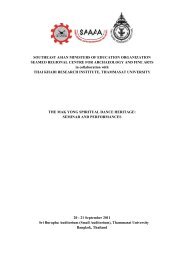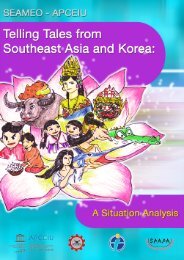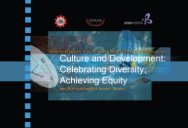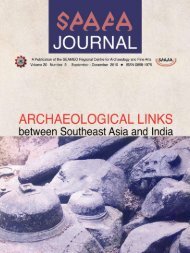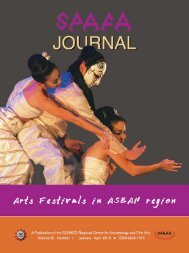Perspectives on Heritage Tourism - Seameo-SPAFA
Perspectives on Heritage Tourism - Seameo-SPAFA
Perspectives on Heritage Tourism - Seameo-SPAFA
You also want an ePaper? Increase the reach of your titles
YUMPU automatically turns print PDFs into web optimized ePapers that Google loves.
<str<strong>on</strong>g>Perspectives</str<strong>on</strong>g> <strong>on</strong> <strong>Heritage</strong> <strong>Tourism</strong><br />
<str<strong>on</strong>g>Perspectives</str<strong>on</strong>g> <strong>on</strong> <strong>Heritage</strong> <strong>Tourism</strong><br />
By and large, the situati<strong>on</strong> of heritage c<strong>on</strong>servati<strong>on</strong> and preservati<strong>on</strong><br />
in Southeast Asia varies in each country: the countries with limited<br />
financial resources and expertise always face similar, and at times,<br />
graver, problems. In order to preserve heritage sites, it is imperative<br />
that risk management, c<strong>on</strong>servati<strong>on</strong>, and use of heritage are wellplanned,<br />
timely, proactive, and relevant. Resources should be used<br />
judiciously, and managers of heritage should be skilled. Community<br />
involvement in c<strong>on</strong>servati<strong>on</strong> at the <strong>on</strong>set should also be given further<br />
importance. Participatory management of the c<strong>on</strong>served resources<br />
is an appropriate means of dealing with the local people with regard<br />
to their own resources.<br />
Indeed, individual approaches, soluti<strong>on</strong>s, and evaluati<strong>on</strong>s of management<br />
practices need to be publicly shared for the mutual benefit<br />
of all involved. This can help ensure that these cultural resources,<br />
when integrated with tourism programmes, are managed with<br />
integrity and that ec<strong>on</strong>omic, social, and aesthetic needs can be<br />
fulfilled.<br />
<strong>Tourism</strong> is viewed not <strong>on</strong>ly as a business but also as a field that<br />
is integrated with and spread across many disciplines. As both<br />
tourism and heritage management evolve, there is a palpable need<br />
for cultural resource managers to be better equipped in meeting<br />
the demands of the professi<strong>on</strong>. The future success of cultural<br />
resource management is hinged <strong>on</strong> human resource development,<br />
and a good start is in developing future experts in this field. The<br />
challenge is to imbibe in them a more holistic and sensitive approach<br />
to cultural management and tourism. After all, cultural resource<br />
managers assume a more prominent role in the increasing<br />
significance of heritage resources in tourism today and in the<br />
future. Thus, I find it obligatory for students of tourism and heritage<br />
management to have knowledge of other related and relevant<br />
fields.<br />
68<br />
Having been a part of the academe for decades now, I have the<br />
utmost respect and appreciati<strong>on</strong> for the role of universities in<br />
cultural resource management, especially in the West. Universities<br />
are some of the most ardent supporters of heritage preservati<strong>on</strong><br />
and have advised their communities or countries <strong>on</strong> policies relating<br />
to cultural management, <strong>on</strong>e of the major pursuits of the academe.<br />
N<strong>on</strong>etheless, are the universities doing enough, especially in the case<br />
of Southeast Asia? <strong>Heritage</strong> management courses were developed<br />
by universities to resp<strong>on</strong>d to c<strong>on</strong>servati<strong>on</strong> needs. Improvements<br />
to these programmes are c<strong>on</strong>stantly needed to counter the rage<br />
of destructi<strong>on</strong> of cultural resources. Why is it then that in Southeast<br />
Asia, university courses offered so far are less resp<strong>on</strong>sive<br />
to the evolving nature of managing heritage resources? Instead,<br />
tourism courses are developed faster, which in many cases are more<br />
m<strong>on</strong>ey-oriented and not exactly c<strong>on</strong>servati<strong>on</strong>-c<strong>on</strong>scious.<br />
Charges are occuring rapidly, and as menti<strong>on</strong>ed above, the issues<br />
faced by cultural resource management (CRM) professi<strong>on</strong>als are<br />
becoming more complex and varied. The skills of those involved<br />
in heritage management need to c<strong>on</strong>stantly adapt to challenging<br />
situati<strong>on</strong>s, and this is where universities come in. There is a big<br />
questi<strong>on</strong> now about whether university courses <strong>on</strong> CRM are<br />
resp<strong>on</strong>sive, relevant, and timely.<br />
University courses need to be improved through the adopti<strong>on</strong> of<br />
a multi-disciplinary approach to cultural resource management<br />
Essentially, CRM is a multi-disciplinary subject incorporating<br />
business administrati<strong>on</strong>, heritage site c<strong>on</strong>servati<strong>on</strong> management,<br />
heritage tourism, archaeology, museum studies, visual and performing<br />
arts, advertising, etc.. The aim or purpose is shifted from the purely<br />
educati<strong>on</strong>al to being both educative and ec<strong>on</strong>omically profitable.<br />
69



